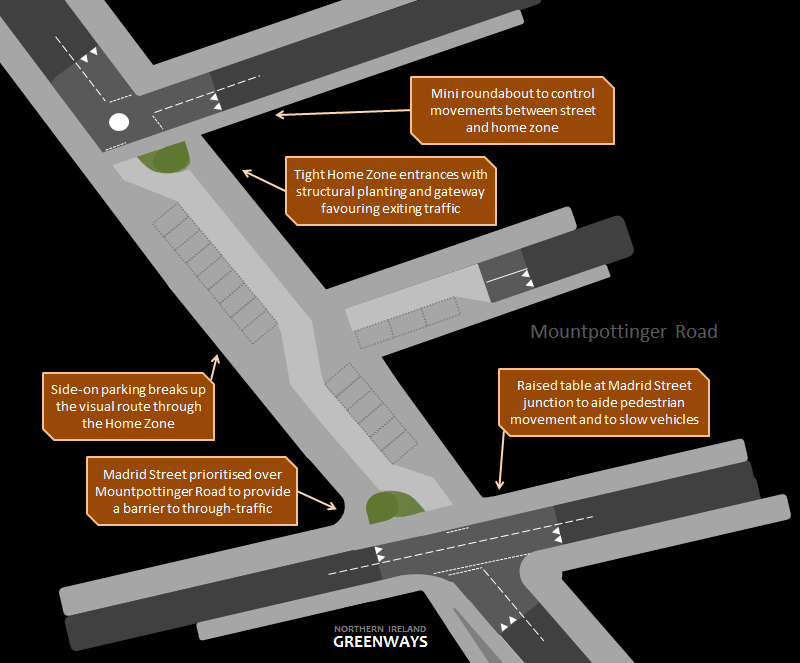
Residents in Belfast’s Short Strand have campaigned for years to calm the traffic on Mountpottinger Road, a key rat run for traffic using the city’s Cross Harbour M3 Motorway. A recent £275,000 road upgrade promised improvements for pedestrians, but the resurfacing scheme appears to have made the traffic situation worse. It’s time to remove all through-traffic to allow families and children to reclaim Short Strand’s streets before the shocking level of HGV traffic, which ignores a more suitable bypass, causes a major tragedy.
Short Strand road safety works good to a point; failed to remove heavy vehicles and rush hour rat run pic.twitter.com/eN8Mkpf8QU
— NI Greenways (@nigreenways) July 2, 2014
The Bull Run
The Short Strand community in East Belfast should be a very quiet residential area, free from traffic concerns. Due to the legacy of The Troubles it is penned in by Peace Walls, with just 3 road gateways – Bryson Street, and at either end of the main spine through Mountpottinger Road and Link.
Titanic Quarter and the M3 Motorway (the key strategic traffic corridor in central Belfast serving the Westlink, M1 and M2) sit to the north, and directly to the south a huge junction links the Ravenhill, Woodstock and Cregagh, Castlereagh, Albertbridge Roads, as well as one of just three bridges linking East Belfast to the City Centre, the Albert Bridge.
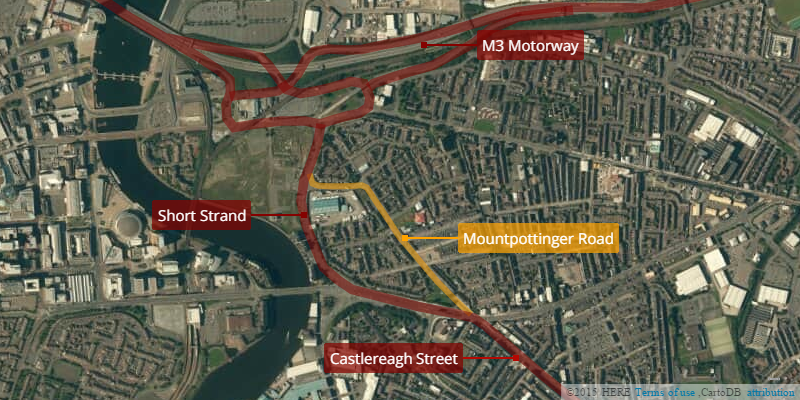
The four-lane Short Strand bypass should be the most preferable route for journeys between the M3 and Castlereagh Street, however a significant volume of general traffic cuts through Mountpottinger Road – most obvious at evening rush hour with long southbound tailbacks.
How bad is the situation for this otherwise sleepy residential area? Here’s a condensed 35 minutes of footage during a Friday rush hour (just after 9am) which shows the scale of the problem:
That’s 37 trucks and HGVs passing through (more than one every minute), white van man filling his boots with 41 commercial vans passing through, and an overall traffic level of around 500 vehicles per hour. The vast majority of vehicles simply enter at one end of Mountpottinger and leave at the other.
The Department for Regional Development (DRD) was at pains during the traffic reduction scheme in Belfast City Centre – Belfast on the Move – to distinguish between vehicles which had a purpose and destination in the area and those which had “no business there”. There is no more apt description for what’s happening on Mountpottinger Road. To label it a rat run perhaps minimises the scale of the problem.
"Rat run" doesn't do Mountpottinger Rd justice @stevenpatt99 it's a bull run, a daily elephant migration #Belfast pic.twitter.com/FkFmWxYiB4
— NI Greenways (@nigreenways) October 16, 2015
The nature of these streets is very different to most of inner city Belfast. Children ride bicycles and scooters along and across Mountpottinger Road; they cross from the play-park to the shops; they roam care-free in the shadow of a constant stream of through-traffic. Collisions have occurred in the past and because of how this road is being used (or abused) a tragedy lies in wait for a local family in the future.
Why do drivers cut through Mountpottinger Road?
On the surface it seems strange that drivers wouldn’t use the route around Short Strand – marked in red on the map above – it’s wider, has more capacity, feels ‘faster’, and has no house frontages and very little pedestrian footfall. However some quite obvious and more subtle factors are at work which make Mountpottinger an attractive choice.
Northbound
Arriving at the Castlereagh Street junction with the Albertbridge Road, drivers are faced with a problem. The route around Short Strand involves a left turn, however the view is obscured by Bank House. Drivers can’t calculate possible hold-ups due to the volume of traffic (which can be at a standstill during rush hour) or if the lights at the Woodstock Link junction will catch them – the first of three potential red lights.
Ahead lies a wide opening to Mountpottinger Road – almost never congested heading north – and the subtle influence of being able to see buildings and hills in North Belfast.
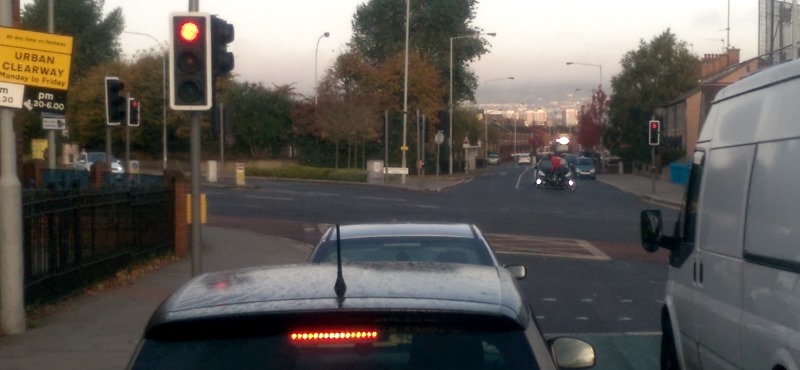
All the way down Castlereagh Street to this point, HGV drivers have seen the variable speed signs on the M3 Bridge peeking over the tops of the houses in Short Strand. Your destination is straight ahead, while an uncertain gamble lies to your left.
Southbound
There is less of a visual incentive to rat run when heading south, with the sweep left towards the Ravenhill junction inviting you to carry on past the immediate turn into Mountpottinger Link. Yet during the evening rush especially, stationary traffic around the Bridge End gyratory has already frustrated many drivers.
Ignoring the rat run takes you to a filter lane which has a triple whammy of frustration for impatient drivers – a signalled pedestrian crossing, an unsignalled exit and even a cycle lane to worry about – all of which means guaranteed congestion at rush hour. After that, another set of lights has to be negotiated at Woodstock Link, and the difficult-to-reach right filter lane for Castlereagh Street has a fast light sequence which can lead to long queues and delays.
Overall, both north and south routes though Mountpottinger involve just two sets of lights – one of which is an infrequently used toucan crossing – and a good chance of a beating queues. The more appropriate bypass has three signal-controlled junctions, three chances to hit a queue, and also means mixing with ‘strategic traffic’ funnelling through a mega-junction with multiple destinations.
The Mountpottinger rat run is a gamble with extremely favourable odds at rush hour, and no worse than evens at any other time.
Radical intervention
Local residents’ campaigning for traffic calming measures recently seemed to pay off. Road humps have been a feature for many years, yet these have failed to tackle the underlying issue. When a road re-surfacing scheme was announced for 2013-14, it was a chance to give serious thought to reducing the attractiveness of Mountpottinger Road to through-traffic. The main change was a puffin crossing at the play park beside The Strand Bar, widely welcomed as bringing “benefits for all road users and pedestrians in the local area.”
However, the enhanced channelisation of the road – providing a central hatched area to create turning boxes for vehicles – was a clue that the needs of vehicle movement and safety was being elevated above the need to reduce traffic volume and speed. Channelisation simply allows vehicles to smoothly travel past stationary vehicles waiting to turn right which might otherwise halt traffic flow. Instead of making Mountpottinger Road a quiet street where people could cross anywhere, installing a puffin crossing was an admission of defeat – we can’t do anything about the flood of traffic, so here’s one good crossing point.
And the overall result of the road improvements? Residents will tell you the traffic levels are as bad as ever, and HGVs rattle through all day every day, hardly noticing the road humps as they heave their loads.
The problem is DRD didn’t proceed with an explicit aim to remove through-traffic – instead it ended up aiding and accelerating the typical through-journey, skewing the risk/reward balance in favour of rat-running.
https://twitter.com/OnTheFence22/status/618683697928249344
What is required now is a far more radical intervention, with the sole aim of displacing strategic through-traffic back onto the strategic route around the area and reclaiming the streets for local residents, families and children. A 20mph zone should be introduced tomorrow, but physical changes to the streets are badly needed.
My preferred street redesign (intended to kick off discussion) is based on three key principles:
- Remove *all through-traffic (see 2)
- Retain the Metro 5A bus service through Mountpottinger Road
- Provide a design solution with the least inconvenience to local vehicle movements
Dissuasion at the entrances
The visual attraction to straight-ahead rat-running from the Castlereagh Street junction must be eliminated. To begin with, any scheme intending to reduce traffic levels on Mountpottinger Road will mean two exit lanes will be unnecessary, so the road should be tightened to one lane in, one lane out.
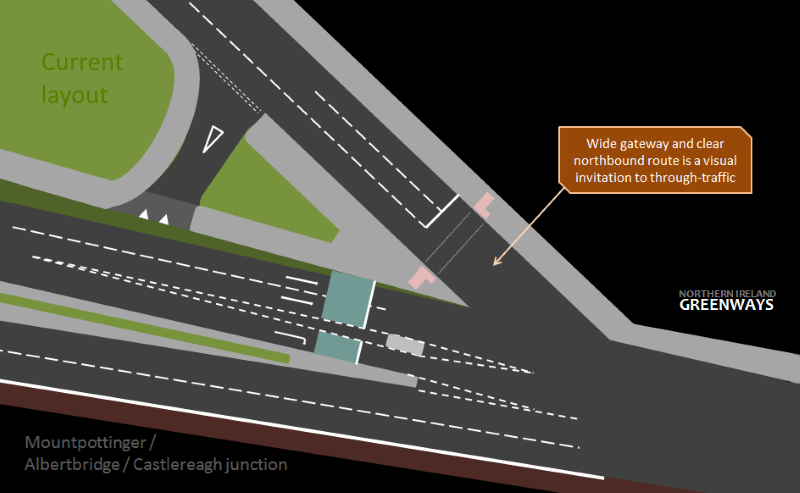
Shifting the ‘entrance lane’ over to the right will break up the visual invitation to fly straight ahead, and some structural planting, trees etc. will add to the feeling of a barrier. However the goal is not to close the entrance – so as to inconvenience local residents – but to plant a seed in drivers’ minds that this is a residential street, not a ‘main road’. Earlier signage on Castlereagh Street can flag up ‘No through road’ or ‘Unsuitable for HGVs’ to further dissuade use.
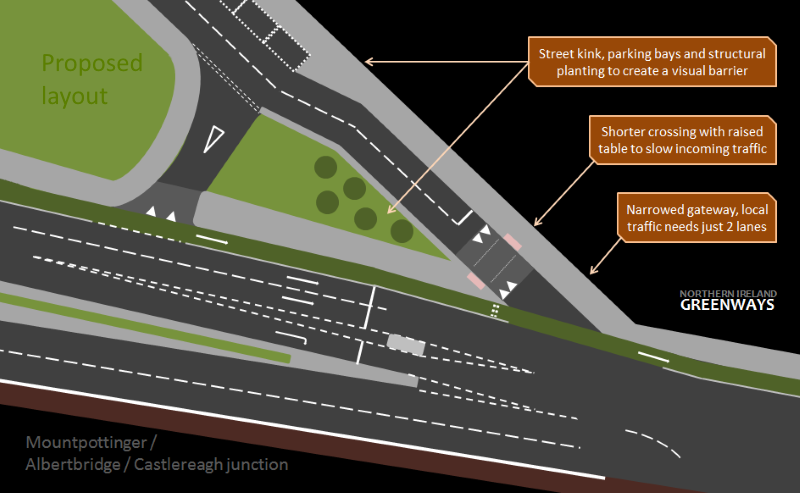
At the Mountpottinger Link end, the sweeping filter lane allows HGVs to trundle through at speed, again tipping the risk/reward balance towards rat-running.
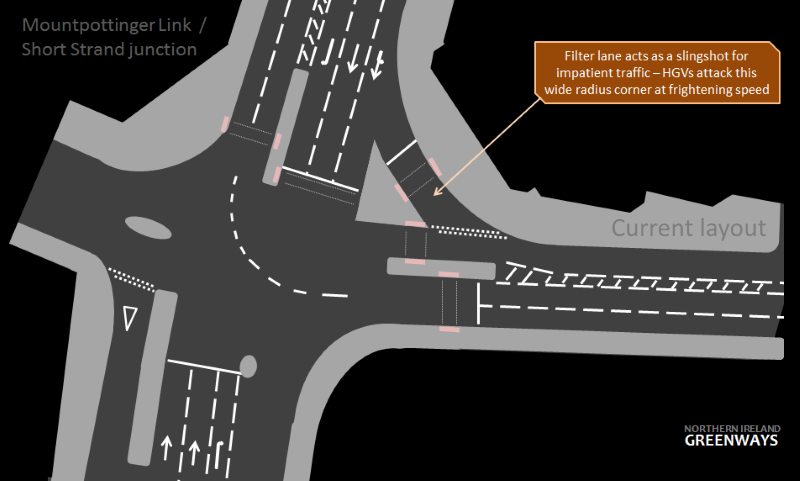
Removing this filter lane, and designing a tighter turn into Mountpottinger Link will allow residents and buses to access the area, but will be slower – making it more difficult for trucks and articulated lorries to negotiate. The straight-ahead option becomes far more attractive in drivers’ minds.
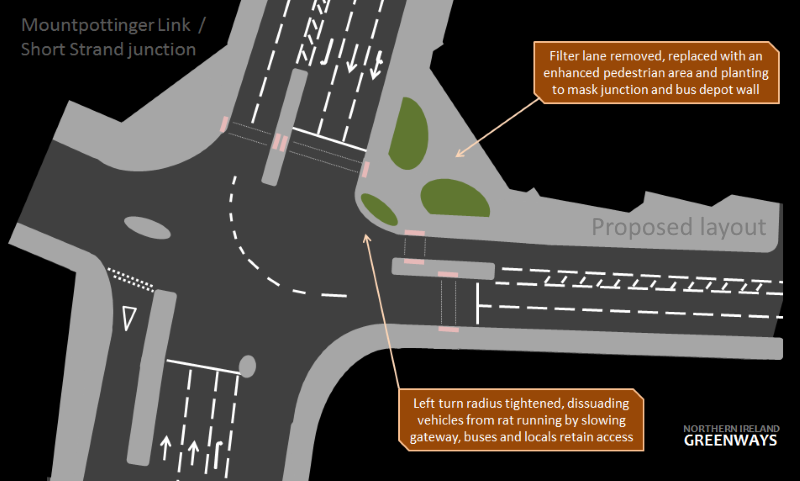
On their own, design changes at the gateways will only dissuade general traffic, but not stop rat-running. Ideally, blocking up Mountpottinger Road at some point would achieve this aim, but would fall foul of objective 3 – annoying local residents to the point of probable objections. One solution however offers a way to ‘snip’ the road without actually closing it to traffic – a Home Zone.

The Dings Homezone development, Bristol (Picture Library Sustrans on Flickr)
These interventions have been trialled in England (but never here) and are a way to radically alter the design of a street to provide strong visual cues to drivers to alter their behaviour, including using build-out elements and designated parking areas to create chicanes to further control speed and movement.
A Home Zone on a short stretch of Mountpottinger Road, in conjunction with work at the gateways, has the potential to solve all the traffic issues in the area at a stroke.
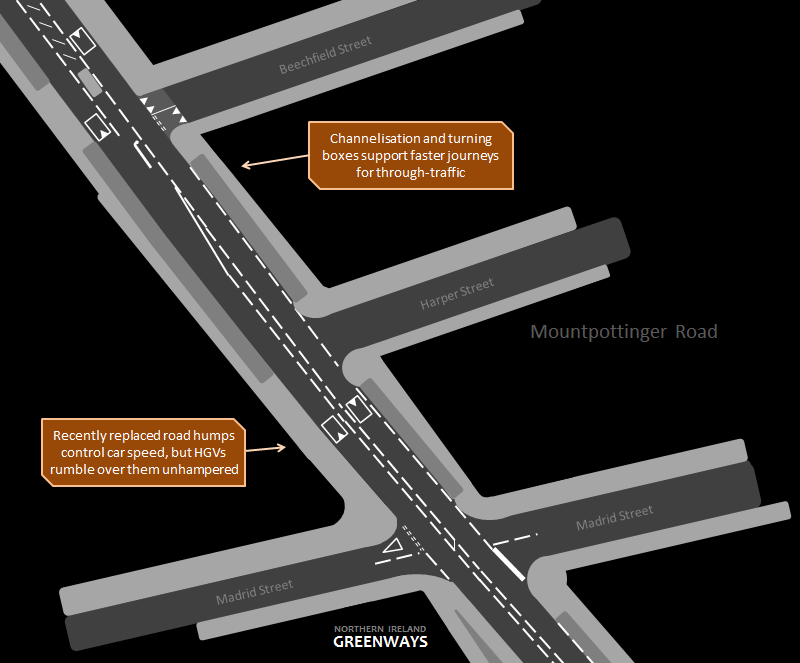
At the southern end, Madrid Street could be quickly redesigned as a through-road, requiring northbound traffic on Mountpottinger Road to stop and give way. The entrances to the Home Zone could be placed on the right hand side of the road to further confuse users arriving for the first time. Now instead of a fast through-road, general traffic would need to make a significant diversion along Lisbon Street to the left and Edgar Street to the right.
The Home Zone itself could be designed with a single lane, allowing only one vehicle to cross comfortably at a time. Signage for the home zone could include ‘No through-traffic’, ‘Buses, access and parking only’ as more ways to make people wishing to drive through feel uncomfortable and unwelcome. Metro bus services would be the only through-traffic to regularly use the Home Zone – not ideal, but socially important for the area. 10 buses per hour would be an acceptable trade-off to remove hundreds of other vehicles.

The Home Zone area would be paved to indicate to drivers that this area is not a road for driving at speed, but is for a different purpose. At the northern end a mini roundabout could facilitate movements to/from the Home Zone and between Mountpottinger Road and Beechfield Street.
Drivers arriving expecting to scurry through the area at speed would be met with a series of visual and physical obstacles to progress which, encountered once, would plainly stop any thought of future rat-running.
The benefits of a Home Zone solution include:
- Radically altered streetscape to remove propensity to rat run through the area.
- The impact on local residents would be minimal.
- Risk/reward of rat running tipped away by slower journeys and embarrassment of travelling through a clearly residential place.
- Bus services can continue to move through Mountpottinger Road.
- Access retained for emergency services, municipal and utility services, residents parking and local movements.
- Walking, cycling and street play is promoted through a more pleasant road environment and radically reduced traffic levels.
- Local vehicle movements across the Home Zone are still possible, if not as attractive as before.
- Two alternative local routes (Lisbon and Edgar) are available on either side.
Any possible delays to Metro 5A service due to these streetscape changes would be offset by a more reliable journey times at rush hour, with tailbacks eliminated at the junction towards Castlereagh Street. An agreement would need to be reached with Translink to ensure that non-operational services – empty school buses and terminated services – returning to the Short Strand depot would use the bypass route rather than the Home Zone.
The Short Strand faces a daily invasion by impatient drivers, a shameful situation which makes a serious or fatal collision seem inevitable in the near future. The quality of life for residents, young and old, is unnecessarily affected by noise, vibration, fumes and physical danger, and the main authorities with a role in changing the situation – DRD, Belfast City Council to name but two – will fail us by ignoring the problem. A Home Zone-centred street redesign has the potential to make a difference, but a better solution may be out there – it’s time to start that discussion. Through-traffic has no place on these streets, and for the good of Belfast we need to take a stand and recognise the need for change. Short Strand residents could draw some inspiration from their counterparts in the Amsterdam neighbourhood “De Pijp” over 40 years ago..